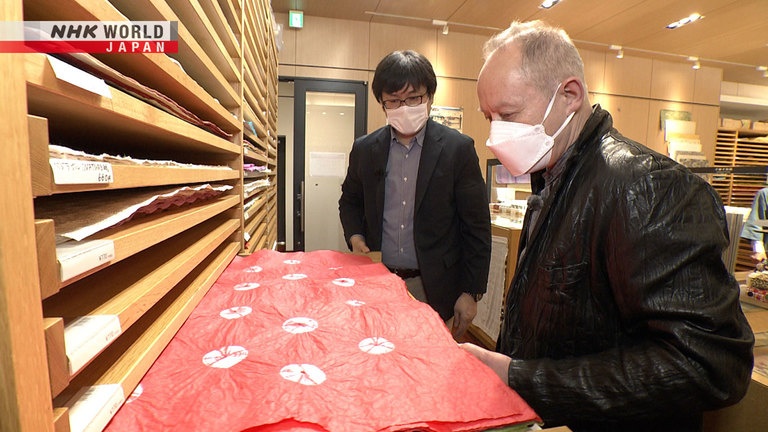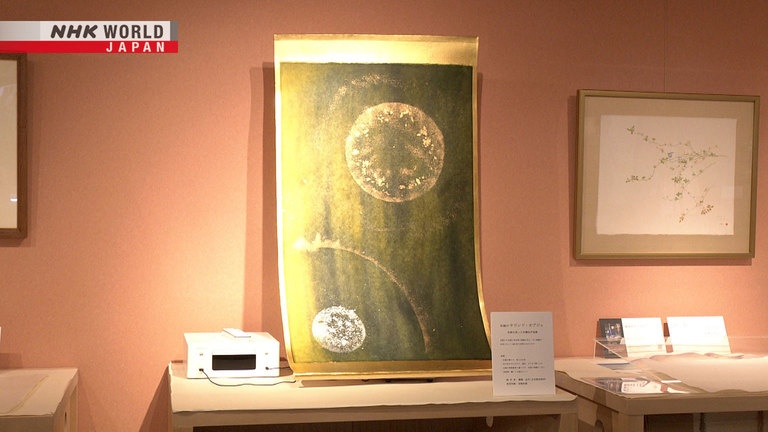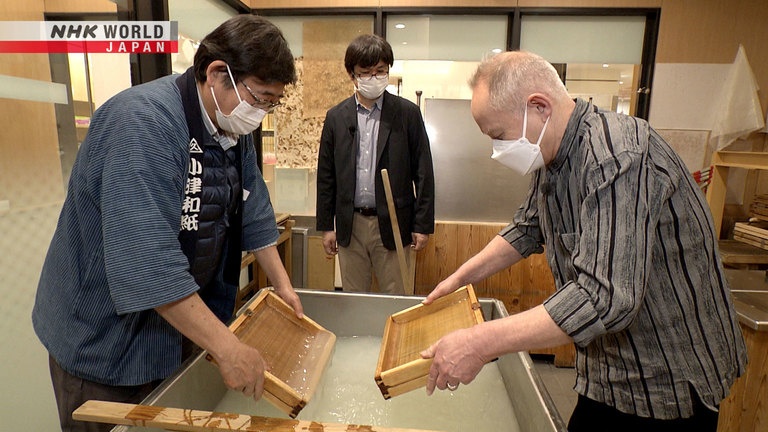Washi: Japanese Paper
*First broadcast on April 28, 2022.
Japanese paper, known as washi, is attractively textured and extremely durable. For centuries, it has been used in many aspects of Japanese life and culture. Our guest, Akutsu Tomohiro, talks about his work repairing and reinforcing old documents using washi. He introduces various techniques used in Japanese paper making, and shows us some surprising new products. We also meet modern artists and craftspeople who are exploring new possibilities for washi.



Transcript
Hello, and welcome to Japanology Plus.
I'm Peter Barakan.
I'm standing in front of Sensoji,
the Buddhist temple in Asakusa which is
an iconic tourist destination in Tokyo.
The gate at the entrance to the temple
here is called "kaminarimon,"
literally, "thunder gate."
And that's what's written in
big black characters there
on that enormous red lantern.
It's nearly four meters high.
The lantern is replaced every ten years.
In other words, once it's made,
it lasts for a full decade,
which is quite amazing when you consider
it's made out of paper.
But then, durability is one of the
big features of Japanese paper,
known as washi.
Washi makes an appearance in all
different facets of Japanese life,
as we'll find out in today's program.
Hello.
Hello. Thanks for having me.
Nice to meet you.
Our guest, Akutsu Tomohiro, works at
the National Archives of Japan.
He uses washi to repair and reinforce old
books and documents.
Akutsu has a deep understanding of washi
and its cultural significance,
and he is involved in efforts to promote it.
He takes us to a washi store.
It was founded in the mid-17th century.
The shop stocks over 3,000 washi
products, sourced from all over Japan.
Here we have chiyogami decorative paper.
There are many patterns.
Wow, there really is a lot of
different kinds.
They include flowery patterns,
and traditional dragonfly designs.
And these are used primarily for what?
They're used to cover boxes, for example.
Handicrafts like that.
You have ones like this that are like
a whole painting.
Yes. In the past, images like this were
created using woodblock printing.
Now we can machine print them.
Right. Each white area was bunched up
before the paper was dyed.
This introduces an element of
randomness.
Each sheet is slightly different.
Wrap a present for somebody very
special.
Yes, it's perfect for a gift like that.
This next style is called "rakusui,"
which means "dripping water."
It has holes that look like
drops of water.
When the paper is being made, actual
water droplets are splashed on.
That creates a natural-looking pattern
of holes.
And this would be used for what?
For various handicrafts.
Tapestries, perhaps.
The only limit is a person's creativity.
Next, we have these papers here.
You can draw a picture, or write a poem,
then paste the paper on a fan.
That's how this paper is used.
Washi has long played a major role
in Japanese life.
Let's see some of its applications.
Traditional houses have sliding
screens like this.
They feature thin washi panels
in a lattice frame.
The screens mark the border of a space,
but the paper lets air pass through,
and it also casts a soft, natural light.
Sliding doors, with a large washi
panel on either side,
are commonly used to separate
one room from another.
By combining screens and doors,
the temperature and light in a room
can be somewhat modified.
A traditional room often has a formal
alcove, featuring a hanging washi scroll.
On this you will see a picture,
or calligraphy.
Another classic application of washi
is andon: paper lamps.
Washi generates a distinctive glow.
The paper protects the flame from wind,
and adds a subtle nuance to the light.
Chiyogami features flowery patterns
or other colorful designs
printed onto the paper.
Chiyogami sheets can be used as
wrapping paper,
or for origami and other crafts.
A gift envelope is used to hand over
money on a special occasion,
such as a wedding.
According to custom,
money is unclean—but it is purified
by the white paper.
Japanese banknotes themselves are made
with a material often used in washi.
Traditional umbrellas use washi
with a waterproof finish
applied to a bamboo frame.
You'll see them in kabuki and
traditional dance, too.
At Japanese restaurants and inns,
meals may be cooked and served
in paper containers.
The washi helps to trap impurities
released by the ingredients.
Washi is an essential element of
Japanese culture,
and a beautiful feature of everyday life.
This floor has all sorts of products and
crafts made using washi.
These are all made out of paper? Wow.
You wouldn't think so, would you?
They're so delicate.
They're beautiful, yeah.
Each kimono has a different pattern.
They look wonderful.
Next, let's look over here.
Can you tell what this is?
I don't know what the green's
made out of. Seaweed?
This is actually a washi speaker.
That's a speaker?!
Yes. I'll play something for you.
We can hear the sound
thanks to the washi.
Washi reverberates beautifully,
and it projects sound effectively.
Try touching it.
You'll feel the vibrations.
Those vibrations are the source
of the sound.
And the music spreads throughout
the room.
It also looks good.
It adds to a room's visual impact.
The sound does actually seem to be
coming out of the paper.
It's quite strange.
If you were going to
describe the appeal of washi to
somebody who's never seen it,
what would you say?
I'd say it has a natural texture that's
pleasant to touch.
It's also good to look at, and to work with.
It's a very attractive material.
What's more, it's very tough.
We can demonstrate that with
two strips of paper.
One is Western paper, and one is washi.
I'll link them.
Then you pull them apart,
and see which one wins.
Here.
OK. Here we go.
Pull both ends at once.
This is the washi, and this is
the Western paper.
That's right.
OK, let's see how we go.
It was very easy, wasn't it?
Washi is strong.
Right.
One of the secrets behind that strength
is the length of the fibers.
Right, right.
Each fiber in Western paper is about
one millimeter long.
Have a look at this.
These are the fibers used
in Western paper.
They tear very easily.
You can see how short the fibers are.
Now let's see fibers used in washi.
They're about ten millimeters long.
There's a clear difference.
OK, yes, you can definitely see the length
is completely different, yeah.
The advantage of longer fibers is that
they bond tightly together.
And that is what gives the paper
its strength.
Another feature is durability.
That's essential for my work.
I repair important documents,
using special types of washi.
Let me show you.
OK, so that's an example.
This washi is really thin.
Try touching it.
That's amazing.
That is so thin;
it doesn't even feel like paper.
It's like some sort of extra-thin
fabric or something.
It's no more than 0.03 millimeters thick.
But it's still strong.
Let me show you how I use it
to make repairs.
This is the sort of thing I work on.
It's a document from the 1960s,
made of Western paper.
It's torn, and pretty fragile.
You can see that for yourself
by touching it.
Oh right.
It's in bad shape.
Yes.
Ultrathin washi can be used to reinforce
torn or fragile paper like this.
You apply a layer on either side.
Through the washi, you can easily read
the characters.
But it adds a degree of strength.
Impressive, yeah. And you can read it absolutely clearly too.
When you trim the edges, it's difficult to
tell that the washi is there at all.
You wouldn't know unless
it was pointed out.
No, I wouldn't have known.
Oh that's...yes, that's very impressive.
And of course it's much stronger now.
If you sandwich documents between
two sheets of washi,
they'll endure for decades,
maybe even centuries.
The main reason why washi has been so
widely used in Japan is its versatility.
OK.
Also, almost 70 percent of Japanese land
is covered in forest.
Trees that are used to make washi,
such as kozo,
can be found and cultivated
all over Japan.
Here's a length of kozo.
Take a look.
Oh that's what it looks like. OK.
Basically there's three different types of
trees that are used for washi, right?
Yes. Kozo, mitsumata and ganpi.
Kozo—or paper mulberry—
is the most widely used.
Let's see how kozo is used to make washi.
First, the bark is stripped
from the branches.
The part used is the white inner bark.
This is boiled, then thoroughly washed,
to remove dirt or other imperfections.
Once cleaned, the material is pounded,
to break up the fibers.
They end up about a centimeter long.
These fibers are immersed in water.
The next step involves a viscous substance
obtained from the root of a plant
called tororo-aoi.
When added to the mixture,
this substance keeps the kozo
fibers evenly separated.
Next, the liquid is scooped onto a screen,
and carefully rocked.
That movement causes the fibers to
tangle and form strong bonds.
The more this is done,
the thicker the paper.
The rocking technique is unique to Japan.
Sheets of the wet material are dried
in the sun.
The result is strong, beautiful washi.
Next, Peter's going to try a simplified
method, at a workshop in the store.
First, put the screen in.
Hold it upright. Scoop, and pour.
Scoop again,
then rock the screen 20 times.
Back and forth.
For smooth paper,
the fibers must be evenly distributed.
OK. Another 20, this time side to side.
Very good.
The screen is placed on a paper sheet,
to which Peter's paper will stick.
Now the screen can be removed.
A stainless-steel panel heated to 60
degrees Celsius is used to dry the paper.
Brush it from the middle, to the edges.
Remove the air pockets.
Oh, I see. OK.
After ten minutes,
the paper is completely dry.
The finished washi can now be scraped
off the stainless-steel panel.
Hey, there we go.
Hey presto!
Alright.
Doesn't look quite so professional,
does it?
It looks good!
As long as it's even, and flat,
you've done very well.
Oh, really?
-OK, OK. Very good.
-Thank you.
Here's Peter's sheet of washi paper.
Pretty good!
Paper making arrived in Japan from China
in around the 7th century,
when Prince Shotoku was promoting
Buddhism.
He encouraged the copying of sutras.
This activity required an enormous
amount of paper.
At that time, paper was made from hemp.
Hemp fibers are extremely long and stiff,
and making them usable was a tough job.
That prompted a shift to kozo,
mitsumata and ganpi—
plants that were readily available,
and easier to work with.
A uniquely Japanese method of paper
making emerged.
Paper made in this way is what
we know today as washi.
As Buddhism spread throughout the
country, so too did this form of paper.
By around the 11th century, washi was
a feature of upper class life.
Its beauty and durability led to its use
in paper screens and doors.
In those days,
new and sophisticated cultural pursuits
were blossoming in Japan.
Men and women in high society wrote
poetry on washi paper.
Decorative sheets were created using
layers of colorful paper,
with gold or silver foil sprinkled on top.
Washi's beauty was taken to a new level.
In the 17th century,
paper found more new uses.
Woodblock printing techniques
were established,
and used to create ukiyo-e prints
and newspapers.
Washi became more widely accessible.
Paper playing cards were created,
and paper kites.
Washi was also used to make
beautiful lanterns and lamps.
So what have we got here?
Old banknotes.
In the past, feudal domains would issue
their own paper currencies.
Oh really, they had local money?
Yes.
OK.
These were used from around
the mid-17th century.
And they're made from washi.
At the time, people were making paper
in many parts of Japan,
and the domains harnessed that expertise
to print their own currency.
Modern banknotes carry on
that tradition.
Ah, right.
Washi wasn't confined to Japan.
It was also used in Europe.
Really? What for?
For prints.
Oh.
In the Netherlands, there was an artist
called Rembrandt.
I think I might have heard of him, yeah.
He made prints using washi.
Really?
It adds a soft, pale quality to an image.
The color of the ink doesn't look the same
as it would on European paper.
Rembrandt liked washi,
so he used it a lot.
8-meter-wide panels of illuminated washi
are a feature of this Tokyo
shopping complex.
Each panel showcases a single,
gigantic sheet of handmade paper.
Their creator,
washi designer Horiki Eriko,
has made a name for herself internationally
by defying convention and
developing new techniques.
Here, she uses scrubbing brushes to fling
water onto a huge sheet of washi.
This creates countless holes in the paper.
The many holes will contribute to
a beautiful appearance.
This layer is combined
with a backing sheet
to create a totally original design.
Here's the finished piece.
The shapes created by the splashed water
are subtle, yet visually striking.
Horiki is always coming up with
something new.
Here, she's adding various colors,
simultaneously.
They flow together on the
surface of the screen,
creating an unpredictable design.
Here's a piece made using that method.
The colors and appearance look different
depending on how the paper is lit.
This building, in Kyoto, is another
impressive example of Horiki's work.
To embody the character of
the old capital,
she came up with a design that
resembles a traditional lamp.
The building's exterior is clad with
153 large washi panels.
Panes of glass protect them
from wind and rain.
Horiki created this washi chandelier
with a French crystal maker.
Even the frame is made from
Japanese paper.
Finally, a paper car.
Washi covers almost every surface,
inside and out.
By pushing past the boundaries
of tradition,
Horiki is expanding the possibilities
of washi.
Peter, I think you can see what this is.
It's a pair of jeans. Don't tell me
these are made out of washi!
Yes, they are.
You're kidding me.
Oh my god.
Washi denim.
Yes—washi jeans.
The threads running vertically are cotton.
The horizontal threads are
made with washi.
Paper is lighter than cotton, so these
jeans are lighter than regular ones.
When washi is twisted into a thread,
it's very strong.
It's also very soft, and it feels great.
It...seems there's almost no limit to the
things you can make out of washi.
Right.
Another example is shamisen
with washi covering the body.
Typically, animal skin is used for that part.
That's right, that's right.
But there are animal rights issues,
and a push to use sustainable materials.
So recently, some people have been
thinking about using washi instead.
Musicians tried it out,
and discovered that
it produces a perfectly good sound.
In Echizen, a famous washi-producing city,
one local initiative focuses
on the sustainability
of the paper-making tradition itself.
This paper is made partly from
fruit and vegetables,
including onion, carrot and orange skin.
These ingredients generate
unique colors and textures.
Leading the initiative is Igarashi Masami.
These days, with the workforce dwindling,
less and less kozo is being cultivated,
and so she has been searching
for alternatives.
She enquired at a local factory,
which produces chopped vegetables,
and learned that they could give her
two tons of offcuts per day.
So she set out to make the most of them.
Igarashi spent a whole year testing
different combinations of raw materials.
And eventually, she succeeded in
creating vegetable paper.
Her first recipes featured carrot,
potato and onion,
balanced with an equal amount of kozo.
Each vegetable imparts a different color
and texture to the paper.
Igarashi collaborated with a local
designer to create various products,
including bags, bowls and notepads.
They sold well, and she now produces 20
different types of washi.
What about the market for
washi these days?
Is it still as vibrant as it always has been?
It has become more difficult to
get hold of raw materials.
But I think that the tenacity of washi
makers offers a lot of hope.
In some areas where there are too few
apprentices locally,
they are being brought in from
other parts of Japan.
Then they are trained so that they can
keep the industry going.
Right.
Another initiative is taking place in
schools in washi-making communities.
Children make the paper for their own
graduation certificates.
Oh, that's kind of nice.
They're taught local,
traditional techniques.
Perhaps one student in that group,
or even multiple students,
will take an interest in washi.
Or maybe they'll even go on to work
in the paper industry.
That would be nice.
Also, I get the impression that a lot of
young artists these days
are using washi in their work.
OK.
People are coming up with
all kinds of ideas.
They're breaking new ground all the time.
I myself would love to contribute to
the industry in any way I can.
OK, thank you very much.
It's been very interesting.
Thank you very much.